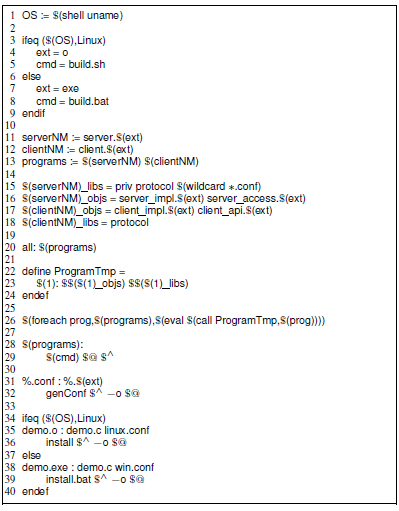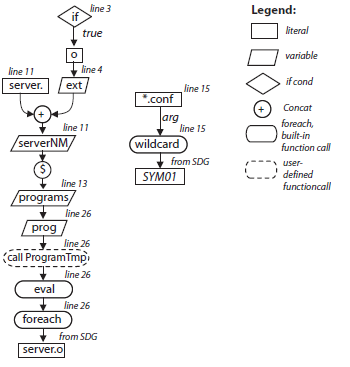Approach Overview
Symbolic Dependency Graph (SDG) and V-model
To address the challenges in the maintenance of Makefiles, SYMake
provides a symbolic evaluation algorithm that processes Makefiles and produces a
single symbolic dependency graph (SDG) to represent all possible build rules and
dependencies among files via commands. It differs from a concrete dependency
graph in make is that file names and commands in an SDG might not be completely
resolved into strings. Instead, the SDG’s node for a file refers to a data
structure, called V-model, i.e. a graph-based representation for symbolic string
values for the file’s name.
A V-model often contains symbols to represent the inputs or data retrieved from
user environment. SDG enables static analysis on Makefiles and supports program
understanding.
Figure I, shows a part of the SDG graph along with the corresponding V-models of
myMakefile [download myMakefile].
 |

Figure I:
Symbolic Dependency Graph and V-models |
|
myMakefile source code |
|
Evaluation Trace Model (T-model)
During the symbolic evaluation, for each resulting string value that represents
a part of a file name or a command in a rule in SDG,
SYMake provides also an
acyclic graph (called T-model) to represent its symbolic evaluation trace. That
is, that T-model shows how that string value is initialized, manipulated and
computed via various Makefile’s program entities.
Figure II, shows the T-models for the string "
server.o"
from figure I, and the symbolic node "
SYM01" of
figure I.
 Figure II: T-models for server.o (left),
SYM01 (right)
Detection of Code Smells and Errors
Figure II: T-models for server.o (left),
SYM01 (right)
Detection of Code Smells and Errors
We have used
SYMake to develop algorithms and a tool to detect several types of
code smells and errors in Makefiles:
Renaming Support with SYMake
Another application is automatic renaming, where SYMake needs to find
all code locations where that variable was initialized/referenced. The key
challenge is that a variable name in make can be dynamically evaluated and composed
from the value(s) of other variable(s). Our empirical evaluation shows that
SYMake renaming accuracy achieves 100% for the subjects
systems we studied.



